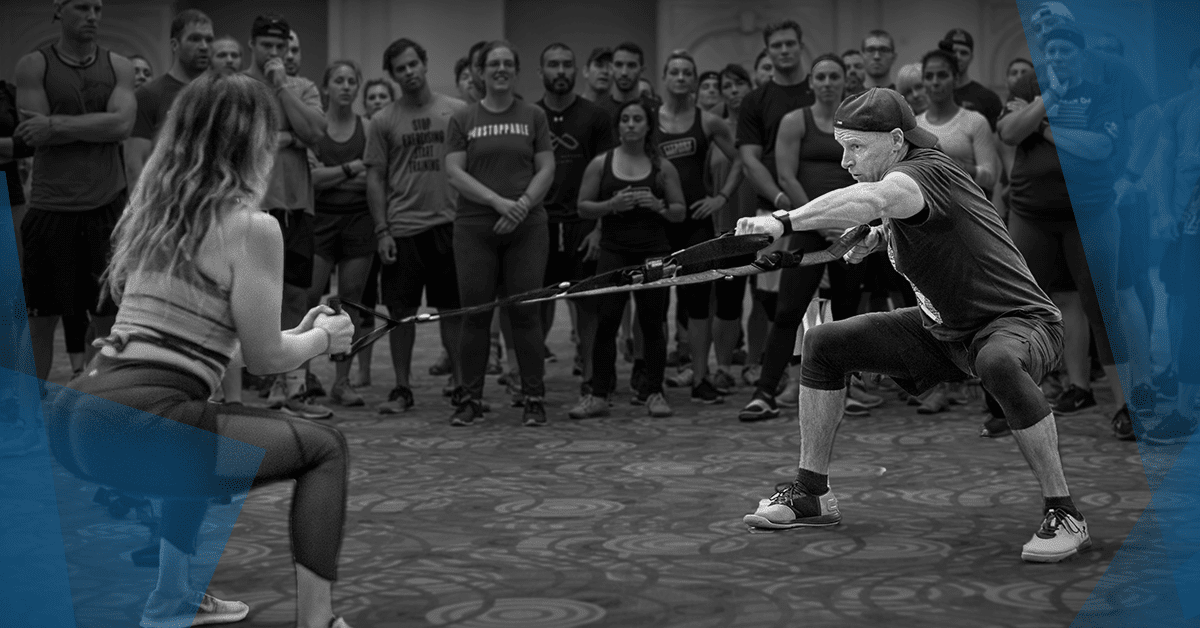Success may appear to come naturally to some. But the truth is, top trainers aren’t born that way. They learn.
At least that’s the case for the five fitness pros who answered this question: What self-education tool changed your career, and why?
While each pointed to a different source of career-shaping advice—a book, a course, a live event, advice from a mentor, and a video series—all lead to the same takeaway: You never know where you’ll find your game-changer.
All we can say with 100 percent certainty is that it’s out there, and you owe it to yourself to look for it.
Melody Schoenfeld
Owner of Flawless Fitness in Pasadena, California, and author of Pleasure Not Meating You
The course: Russian Kettlebell Challenge (RKC) certification
Why: It introduced me to inspiring people and opened doors for me in the fitness world.
I am not a natural athlete. My foray into fitness was motivated by sheer necessity—at the time, I was working in advertising in New York City, making an annual salary of $20,000. Which in the city is roughly the cost of a sandwich. (And not even a very good one.)
As my brother, Brad was familially obligated to offer me part-time work at his training facility. He wrote the programs and taught me the exercises. I in turn taught the programs to the clients he provided.
I first met Pavel Tsatsouline, believe it or not, at a Learning Annex flexibility class he was teaching. I signed up and was impressed by Pavel’s assistant, Mike Mahler, who was a vegan like me but extremely strong and muscular. I've been vegan since 2000, and at the time had not met many vegan strength athletes. I wanted to do whatever he was doing, which led me to the world of kettlebells.
I took Mike’s six-and-a-half-hour kettlebell workshop and pored over Pavel’s book Enter the Kettlebell. Then came the RKC. The course is a grueling three-day kettlebell immersion not for the faint of heart. The sheer volume of moves crammed into those three days left my hands badly torn and bleeding. In the end, I not only passed but was asked to return as an assistant.
Through the kettlebell community, I met the strongmen who introduced me to my current passion: old-time strongman training. I can now tear a phone book in half and bend a half-inch-thick steel bar with my bare hands. I have a reputation for being, pound for pound, one of the strongest women in the industry. Not bad for someone who did not start out as an athlete.
RKC was a turning point for me, but it wasn't the course itself that changed my life—it was the inspirational people I encountered as a result. Should you ever have the opportunity to learn from the best in your profession, don't hesitate to jump on that chance.
READ ALSO: How to Pick a Personal Trainer Certification
Patrick Umphrey
Online coach and founder of Eat, Train, Progress
The lesson: You have to be yourself.
Why: It’s made me happier and more successful.
I had just started my Facebook group Eat, Train, Progress, and I wanted to post a funny meme. Okay, so the meme was a bit dirty—PG13 for adult language—but it didn’t disparage anyone. And frankly, I thought it was hilarious. I had made the meme, after all, so the humor was very me.
Still, I questioned whether or not to post it, fearing it might turn off those who didn’t share my sense of humor. Remember, my group was still young, and I wanted to attract new members, not scare them away.
At the time, I was enrolled in a mentoring group called Elite Fitness Mentoring, run by Luke Johnson and Lawrence Judd of Shredded by Science.
I shared my problem with Luke, and he offered me some important advice that’s stuck with me ever since.
Luke insisted I post that meme. "You need to be yourself, and this is totally you,” Luke said. “Besides, if it really bothers someone enough to leave your group, that's not someone you'll ever be coaching anyway."
The lesson was way bigger than any meme: Putting yourself on display is important. It lets others know who you are, and attracts like-minded people (they’re out there!) who will accept you for you. Those are the people you want around you. Otherwise, you may spend a lot of energy trying to be someone you’re not. And that can be stressful and exhausting.
This philosophy now guides everything I do, including how I run the group and coach clients. My values are present in every action and decision I make, which means that I generally feel good about them.
Eat, Train, Progress now has more than 17,000 members and has had a positive impact on many lives. It’s successful, and I believe that this is at least one reason why.
READ ALSO: How to Build an Online Following from Scratch
Mark Fisher
Cofounder of Mark Fisher Fitness and Business for Unicorns
The event: Perform Better 3-Day Functional Training Summit
Why: It taught me to consider other viewpoints and constantly evolve my approach.
As a guy who routinely wears capes, loud spandex, and unicorn apparel to work, I’m not typically accused of being shy. But the first time I attended a Perform Better 3-Day Summit, that’s exactly how I felt—shy and intimidated by all the muscle-y people.
This was early in my career. At that point, I was an obsessive reader of blogs and info-products, and the summit was one of my first in-person events. I was so impressed that I returned the next year, and the next. By now, it's become one of my annual touchpoints with that particular community of fitness pros.
The lineup features industry legends like Mike Boyle, Dan John, and Stu McGill—but it’s also introduced me to others whose work I hadn’t heard of before. While the 75-minute sessions are less in-depth than, say, a day-long event on a single topic, that's actually the summit’s strength: You’re exposed to a wide variety of ideas and training methodologies.
And because it’s such a smorgasbord, it has helped me become a more critical thinker in two ways:
- It's taught me the value in finding common ground. When you're exposed to a wide swath of methodologies, it’s easy to get bogged down in the differences. And while those differences are worth exploring, I've found that clarifying what everyone agrees on is even more useful.
- Because I've been going for so many years, I’ve had the opportunity to watch people's viewpoints change and evolve over time. For me as a young trainer, seeing that kind of adaptability in my mentors was huge. It gave me permission to continually update my own approach as I absorbed new information, instead of digging into an old belief system that had grown outdated.
READ ALSO: How to Use New Knowledge from a Convention
Leigh Peele
Online coach, mentor, and host of the podcast You Need to Hear This
The book: Burn the Fat, Feed the Muscle, by Tom Venuto
Why: It’s a shining example of evidence-based advice in a world of “bro science.”
Like a lot of trainers entering a fitness career, I began my journey wanting to get myself into shape. I was overwhelmed with the amount (and often poor quality) of information online and at bookstores.
As an early Internet adopter, I went to forums to fulfill my thirst for vetted knowledge. That's when someone recommended Tom Venuto's Burn the Fat, Feed the Muscle. It was simple, addressed science and current research in a modest and level-headed manner, and it sent me in the right direction.
Because of that book, I avoided the traps and dogmatic pitfalls scattered all around the health industry. It appealed to my critical thinking, and I appreciated the evidence-backed principles that still guide my training and career. One invaluable tip from the book: Your goal should always be fat loss, not weight loss.
On top of all of that, Venuto is a natural athlete who encourages consistent and sensible hard work. He stands out in a crowd of what is usually perceived as bro culture. He and the book are the full package.
READ ALSO: Best Books for Personal Trainers
Stephen Holt
Founder of 29 Again Custom Fitness and an 11-time finalist for personal trainer of the year awards from five different organization
The video series: Acland’s Video Atlas of Human Anatomy
Why: It’s the next closest thing to dissecting a human body.
The X factor in any personal training business is not your Instagram or your abs. It’s your knowledge of human anatomy. Without that, you can’t truly understand how exercise works. You can only repeat the motions mindlessly without knowing why you’re doing them.
My education in anatomy—some formal, but mostly self-taught—transformed my career. Books like The Pelvic Girdle and Anatomy Trains were hugely influential—in fact, they led me to develop my 3-4-5 Total-Body Fitness System, which was featured in national publications like Shape and Women’s Health and likely was a factor when I was named ACE Personal Trainer of the Year and a finalist for NSCA Personal Trainer of the Year.
Still, a two-dimensional book can’t touch the detail you get from the turntable shots in Acland’s Video Atlas of Human Anatomy. (I first watched it on DVD many years ago, long before streaming was a thing. But these days, you can stream videos directly from the website for a subscription price.)
These videos made me realize the spiral and diagonal patterns inherent in all major muscles. It was an “a-ha!” moment for me that changed the way I train, informing which exercises I do (and don’t do).
For example, the fibers of the gluteus maximus are diagonal. So a bilateral move like a Romanian deadlift can't take full advantage of the diagonal orientation of those fibers. Even a single-leg Romanian deadlift falls short. The ideal choice: a 45-degree single-leg Romanian deadlift using a cable held in the opposite hand while facing the pulley at an angle. By tweaking the classic move this way, you target those glute-muscle fibers in the most efficient way.
Understanding anatomy allows you to recognize exactly which muscles are doing what, so you can create the best plan for your clients. The human body is the tool of our trade. If you want to be successful, you need to know how it works.











